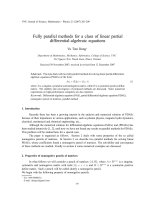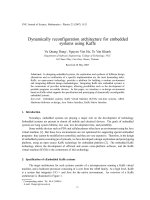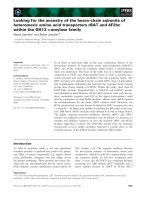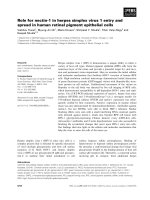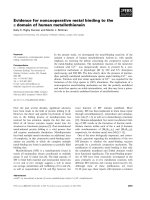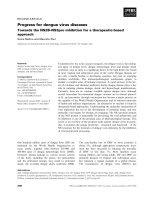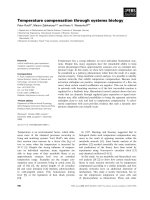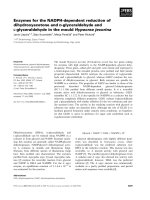Tài liệu Báo cáo "Dynamically reconfiguration architecture for embedded systems using Kaffe " doc
Bạn đang xem bản rút gọn của tài liệu. Xem và tải ngay bản đầy đủ của tài liệu tại đây (236.2 KB, 7 trang )
VNU Journal of Science, Mathematics - Physics 23 (2007) 15-21
Dynamically reconfiguration architecture for embedded
systems using Kaffe
Vu Quang Dung
∗
, Nguyen Viet Ha, To Van Khanh
Department of Software Engineering, College of Technology, VNU
144 Xuan Thuy, Cau Giay, Hanoi, Vietnam
Received 28 May 2007
Abstract. In designing embedded systems, the exploration and synthesis of different design
alternatives and co-verification of a specific implementation are the most demanding tasks.
Kaffe, an open-source technology, provides a platform for building a runtime environment
and integrating different design methodologies. Integrating Kaffe into embedded systems is
the cornerstone of java-like technologies, allowing possibilities such as the development of
portable programs on mobile devices. In this paper, we introduce a co-design environment
based on Kaffe which supports the specification and prototyping of dynamically reconfigurable
embedded systems.
Keywords: Embedded systems, Kaffe Virtual Machine (KVM), real-time systems, ARM,
Hardware-Software co-design, Java Native Interface, Kaffe Native Interface
1. Introduction
Nowadays, embedded systems are playing a major role on the development of technology.
Embedded systems are present in almost all mobile and electrical devices. The goals of embedded
systems are long system lifetime, low cost, low development time, and portability.
Some mobile devices such as PDA and cellular phones often have an environment using the Java
virtual machine [1]. But these Java environments are not optimized for supporting special embedded
programs: they cannot be modified nor controlled, and they are very expensive. Therefore, in the design
of embedded systems executing java bytecode, we have developed a design exploration and prototypying
platform, using an open source Kaffe technology for embedded platform [2]. The embedded Kaffe
technology allows the development of efficient and secure cross-platform software, and the Kaffe
virtual machine (KVM) is the cornerstone of this technology.
2. Specification of eEmbedded Kaffe systems
The target architecture for such systems consists of a microprocessor running a Kaffe virtual
machine, and a hardware processor consisting of a core from the ARM family. At a high level, Kaffe
is a system that integrates C/C++ and Java for the native environment. An overview of a Kaffe
architecture is illustrated in Figure 1.
∗
Corresponding author. Tel: 84-4-7549016
E-mail:
15
16 Vu Quang Dung et al. / VNU Journal of Science, Mathematics - Physics 23 (2007) 15-21
Figure 1. Overview of Kaffe architecture.
Figure 2. Co-design of Embedded Kaffe.
For the purpose of using a java-like technology for embedded systems, we design a distributed
Kaffe system using the Kaffe virtual machine to execute the Java bytecode. The KVM relies on an
interpretation mechanism which emulates the execution of Java bytecode on mobile devices based on
embedded systems. The system architecture consists of a microprocessor running a Kaffe environment
and porting to hardware controlled by an ARM processor. Starting from an initial Kaffe specification,
profiling data is gathered while executing the program with input data. The profiling data is then
visualized to guide the designer in the partitioning process. Partitioning is done at the method level of
granularity using a user interface. Functions which are to be implemented in hardware are synthesized
using high-level logic synthesis tools. Java bytecode is stored in the pool of software methods. For all
methods which are candidates for the implementation in reconfigurable hardware, the ARM processor
controls all information storing in the pool of hardware methods. The target software platform for port-
ing Kaffe environment is an embedded Linux, adapted to real-time systems. A co-design environment
using Kaffe is showed in Figure 2.
Vu Quang Dung et al. / VNU Journal of Science, Mathematics - Physics 23 (2007) 15-21 17
Figure 3. Integrated platform.
3. Co-processor hardware design based on an ARM processor
To manage system integration, a runtime management program has been implemented. The
runtime management program schedules methods for execution either as software on the KVM or as
hardware on the ATEB9200 Evaluation board with an ARM processor controller. Execution on this
system is a dynamic process [3]. The execution flow of the system is dominated by the software part,
executed on the KVM. The core component of the runtime environment is the KVM. It consists of
a class loader for dynamically loading Java bytecode and an execution engine for interpreting these
bytecode on the ARM processor. An integrated system is shown in Figure 3.
The class loader is extended for reading in the current system partitioning table and for handling
hardware methods, executed on the ATEB9200 Evaluation board. The execution engine needs to know
whether a method is to be interpreted as bytecode or executed in the ARM processor. For this reason,
the class loader assigns a special flag to every hardware method. During execution of the application,
the interpreter has to activate the hardware call module whenever the flow of control reaches a hardware
method. The hardware wrapper implements the procedures, which transfers input data to the board,
executes on the ARM processor and transfers the resulting data back to the calling thread.
For the ease of using the system model above, we propose some ideas for a simple implemen-
tation of Kaffe in the co-processor hardware on an ATEB9200 board that will lead to an increase in
performance [4], as shown in Figure 4. Within the block diagram, all connections are 32 bits wide
with one exception. This is due to the fact that Java byte-code is built on a 32-bit architecture. The
exception is the connection between the Stack cache and the arithmetic units that is 96 bits. This
allows for long operands to pass from the cache to the arithmetic units in a single cycle.
The logical blocks that are unique to this design are the ARM I/O interface and the interface
controller. The interface is connected inside the ATEB9200 board to both the instruction and data
caches as well as the interface controller. Instructions for execution flow through the interface and
into the instruction cache for execution.
The interface controller maintains the link between the Kaffe system and the ATEB9200 board.
It is responsible for halting the hardware in the event that execution needs to stop while the KVM
carries out part of the execution. In addition, it is responsible for changing the context of the current
18 Vu Quang Dung et al. / VNU Journal of Science, Mathematics - Physics 23 (2007) 15-21
Figure 4. Hardware design based on an ARM processor.
execution when signaled by the KVM. In essence, it is the hardware mediator between the hardware
and software.
4. Software co-design
Between the Java co-processor, which is in the ARM processor, and the memory that is available
on the board, there must be some interaction. The memory on board is used as an intermediate memory
location between the ATEB9200 system and the Kaffe co-processor. As the ATEB9200 system resolves
classes and sets the location of execution with the Kaffe coprocessor, it places into the board’s dynamic
memory RAM the class itself and the instructions that are located at the address of execution. The
Kaffe co-processor through its I/O interface retrieves data from the memory and brings it into the
instruction cache on the ATEB board for execution, similar to [5]. The memory must also contain any
data that cannot fit into the data cache and is used too often to be swapped back out onto the ATEB
system.
To handle the amounts of data that are being transferred back and forth between the ATEB9200
system and the card, in the event that the memory on board is not sufficient to hold all the application
and necessary data generated, the memory must be split into manageable blocks to allow for quick and
efficient transferring.
For this reason and based on [6], we propose in Figure 5 the software design of Kaffe co-
processor, which supports the execution of the Java byte-code on the ATEB9200 board. This design
consists of the threads of execution that are necessary in the software to support the Kaffe co-processor.
Each of the threads are standard threads within the Kaffe virtual Machine except for the Hardware
handler that is added for communicating with the ARM processor interface. The hardware handler
is also an essential component in the communication of data between the Kaffe co-processor and the
Java byte-code. The thread is also used to maintain the synchronization of data between the memory
on the ARM processor and the memory located on the ATEB9200 board.
Vu Quang Dung et al. / VNU Journal of Science, Mathematics - Physics 23 (2007) 15-21 19
Figure 5. Kaffe design of co-processor.
Figure 6. ARM/KVM integration.
5. An implementation of Kaffe architecture based on an ARM processor
Based on [6] and with virtual machine Java-like system design in [4], we have ported Kaffe
into an Embedded system based on ARM processor [7]. We implemented a new model of hardware
and software integration, which executes Java byte code on a hardware device based on the ARM
processor, as shown in Figure 6.
We called a structure of the ARM processor on a Kaffe system following config/arm/jit.h. When
the class is loaded, we built a dispatch table, which contains the pointers to methods. Since the meth-
ods are not yet translated, each dispatch table entry points to a trampoline for the associated method
as written in [8], that has the structure
typedef struct methodTrampoline {
20 Vu Quang Dung et al. / VNU Journal of Science, Mathematics - Physics 23 (2007) 15-21
unsigned char call arm PACKED;
int fixup arm PACKED;
struct methods* meth arm PACKED;
}methodTrampoline;
This structure calls to a native method of the Kaffe Native Interface (KNI) and builds in standard
C using a call for information, which will be stored in the ARM dynamic memory. The algorithm of
this method forms the major function calls in Kaffe’s main.c, that provides an overview of the entire
compilation process of Kaffe.
ALGORITHM for Kaffe on the ATEB9200 device based on ARM processor [9]:
BEGIN
• call machine-specific main.
• set java version.
• get default VM init args.
• setup libtool, device memory.
• get the CLASSPATH, LIBRARYPATH, KAFFEHOME environment variables.
• process the program options.
• get the class name to start with
– * create and initialize the Java VM (calling JNI based on KNI).
– * find the class to start with (JNIEnv *env, char *argv[], int farg, int argc).
– * get the method handle for the main method in the class to start with (calls GetStat-
icMethodID()which is actually Kaffe GetStaticMethodID()to get the method handle for
main() ).
• build an array of strings as the arguments to the Java code’s main()
– * call the main method ( CallStaticVoidMethod() on [10] ),which will cause the entire
program (or the executed portion thereof)to be translated into native code a function at a
time.
• check for errors and then exit.
END
6. Conclusion
We provide an architecture that uses a Java class and native methods inside Kaffe environment
for interfacing with embedded processors. We use the specific API plug-in on Kaffe libraries to write
and read a value that contains the address of the board. These functions are implemented via the Java
Native Interface (JNI) and Kaffe Native Interface (KNI) with Java-C integration. The goal of this
integration is to design and port a Kaffe environment on an embedded processor with clear definitions
of JNI and KNI.
This research demonstrates that a Kaffe co-processor is a practical and effective solution to
Java’s performance problems.
Acknowledgments. This work is partially supported by the Vietnam National IT Fundamental
Research grant 204006.
Vu Quang Dung et al. / VNU Journal of Science, Mathematics - Physics 23 (2007) 15-21 21
References
[1] Didier Donsez, Programmable Architecture on Java 2 Micro Edition, 2006.
[2] Naveed Ahmad, Saddaf Mumtaz, Software architecture of Kaffe, 2006.
[3] J.Fleischmann, A Hardware/Software Prototyping Environment for Dynamically Reconfigurable Embedded Systems,
1998.
[4] Kenneth B.Kent, Micaela Serra, Hardware Architecture for Java in a Hardware/Software Co-Design of the Virtual
Machine, 2002.
[5] The Java Chip Processor: Redefining the Processor Market, Sun Microsystems, November 1997.
[6] Stephan Schulz, Jerzy W.Rozenblit, Michael Mrva, Klaus Buchenrieder, Model-based Codesign, August 1998.
[7] Samuel K.Sanseri, Porting Kaffe to a New Architecture, 2000.
[8] Kiyo Inaba, ”What is trampoline code in Kaffe?”, 1998. The URL at time of this writing is,
inaba/trampolines.html
[9] Azzam Mourad, A Selective Dynamic Complier for Embedded JVM Targeting ARM Processors, 2005.
[10] Kiyo Inaba, ”How sysdepCallMethod works”, 1998. The URL at time of this writing is, in-
aba/sysdepCallMethod.html
